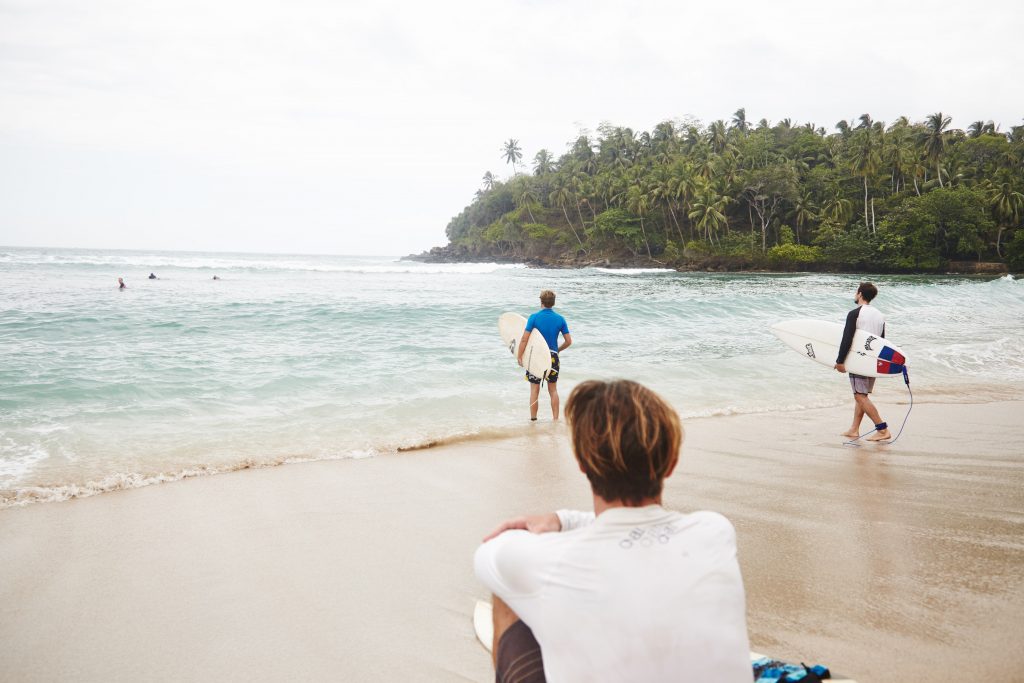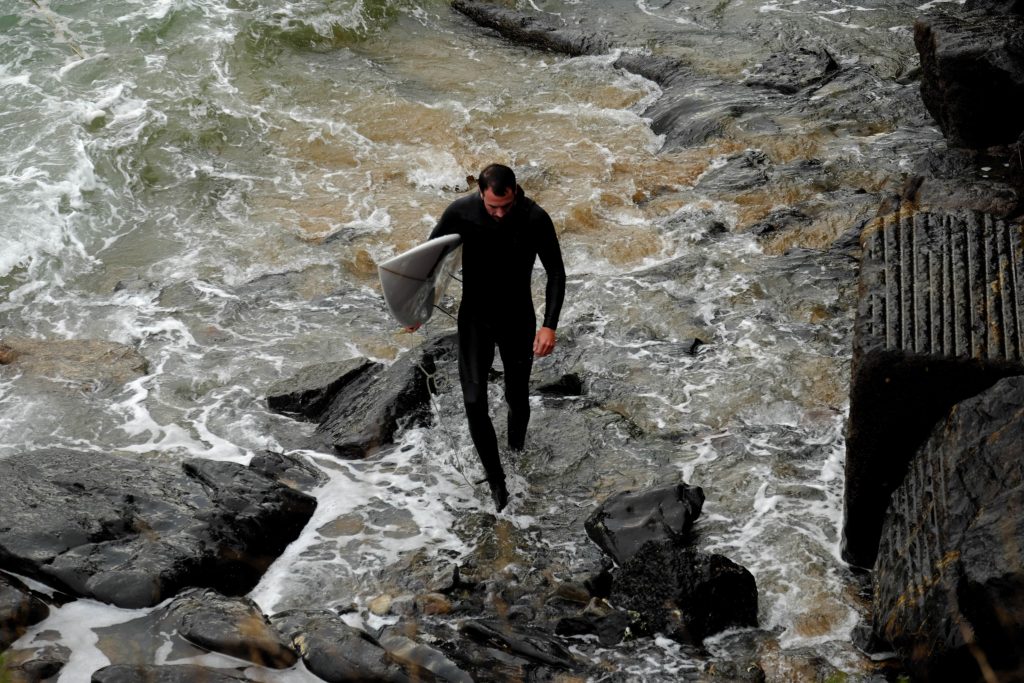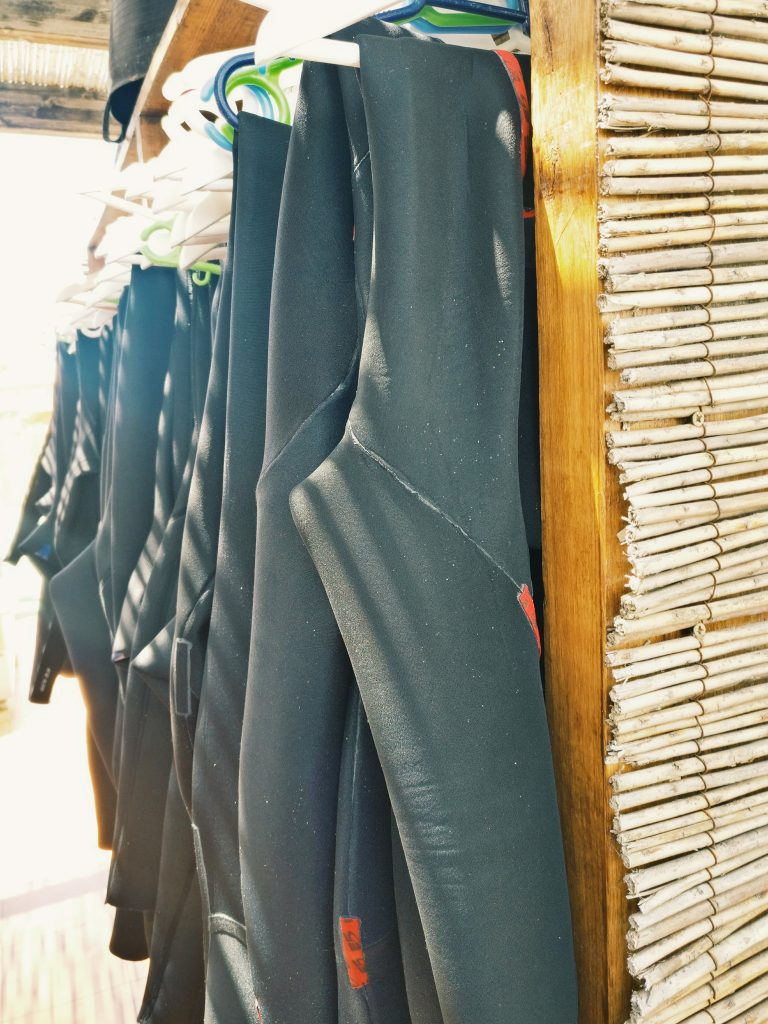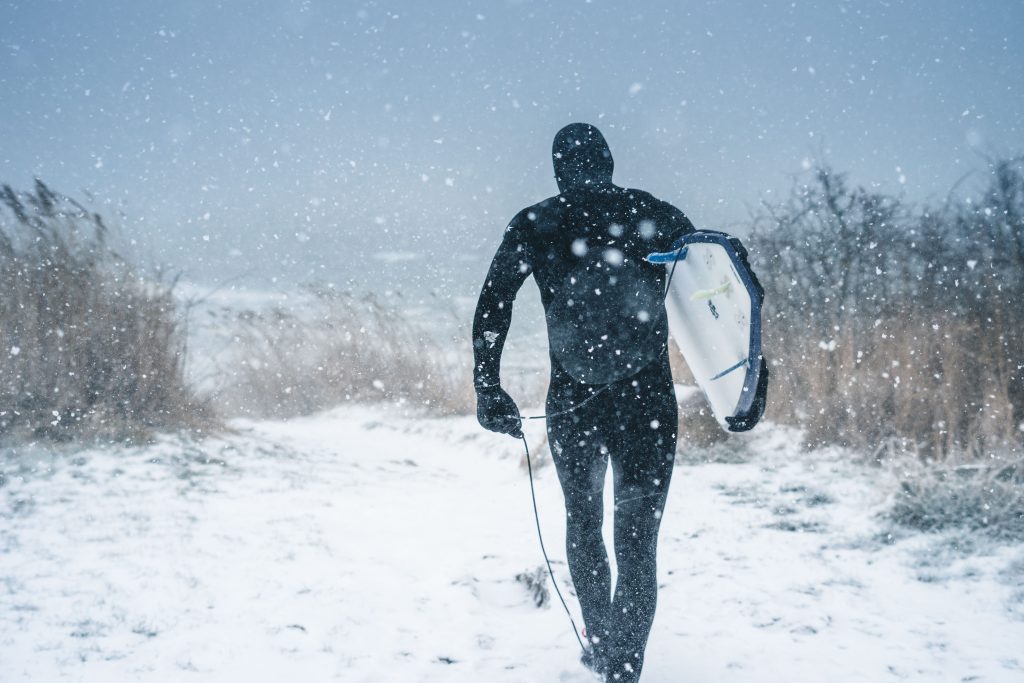The wetsuit
It is the knight in shining armour for all of us who want to go surfing even when just the thought of going out in your boardies or bikini makes you shiver. The wetsuit lets you enjoy your favorite sport in cool waters by keeping your body temperature high and thus preventing hypothermia. It doesn't matter if you want to go diving, do a triathlon, take out your kayak or go for a surf – wetsuits are an important part of many activities and sports, enabling the fun aspect to overshadow the cold.
It is important to keep in mind that the requirements for and specifications of the wetsuit can vary depending on the sport. In this article we will exclusively talk about wetsuits for surfing. Here it is important that the wetsuit provides a good mix of flexibility and thermal insulation, thus minimizing the restrictions on the surfer's paddling and mobility while keeping him or her warm. There are seemingly endless variations of wetsuits for surfing with differing in thickness, style etc. Since we also had to go through the struggle of choosing the right model from this vast array of wetsuits, we thought we might help you find the perfect one for you with this little guide.
Material
As you may already know, wetsuits are made of neoprene – foamed neoprene to be exact – which is an extremely water-resistant material. The warming effect that it has is due to the fact that the neoprene stores a thin layer of water between the surfer's body and the suit, which is then warmed up by the body temperature. At the same time, the wetsuit keeps additional water from coming into the wetsuit. Additionally there are small air bubbles in the neoprene which ensure that no warmth is lost and also that the wetsuit becomes slightly buoyant.
Thickness
One of the most important properties that you should consider when choosing a wetsuit is the thickness, as this translates directly to how warm it will keep you. Thus, you will need different wetsuits for different ocean and weather conditions. While in Bali you can paddle out in a thin 2mm shorty or simply boardies and a lycra, you will need a 5/6mm full-suit as well as gloves and a hood in Ireland.
So, the thickness of your wetsuit will be different depending on the situation you want to use it in. Normally they are available from 1 to 6 millimeters thick. It is important to know that different parts of the wetsuit have a different thickness. The middle part of the suit is thicker to keep it warm while the shoulders, arms and legs are thinner to ensure better mobility. Due to this distinction, the thickness of a wetsuit is described by two numbers. A 3/2 wetsuit, for example, is 3mm thick in the middle of the body and 2mm thick on the shoulders, arms and legs.
Types
Not only the thickness but also the cut of the wetsuit have an effect on how warm you will be in it. The specific wetsuit which will be best for you will depend on the air temperature, the wind, how much you move and how easily you get cold. The temperatures used below should only be seen as a rough reference point). In the following we will first present the different types of wetsuits.
Lycras, rash guards and surf tees
When the water temperature is sufficiently high, you won't really need to wear a wetsuit for surfing. Nonetheless, since you are not only directly exposed to the sun when wearing only a bikini or boardshorts but to rashes from the waxed board as well, we would recommend you to wear a lycra, rashguard or surf tee. Strictly speaking, these obviously aren't wetsuits nor are they made from neoprene but should still be mentioned to provide a complete overview of possibilities. Lycras are skin-tight, while surf tees are a bit wider. Both are made from very light, fast drying materials and can be washed in the washing machine. These have proven to be the best outfit for surf sessions in tropical waters of over 23°C.
Neoprene tops, surf leggings and shorts
Despite warm water and air temperatures you might get cold after being in the water for a while. Therefore you should consider wearing neoprene tops and shorts or surf leggings for longer surf sessions. Compared to lycras these provide better thermal insulation and increased protection from the sun. The same goes for neoprene vests, which you can also wear under your wetsuit to have an additional layer as an additional warming layer.
Springsuits and shorties (0,5 - 3 mm)
Springsuits and shorties are short wetsuits that are available in various styles and cuts with different features. While these differ regarding the length of their sleeves and legs as well as the area around the neck/collar, all variations provide sufficient warmth for the mid-part of the body. These should be used when the water is at least 20°C warm.
Steamers (2 - 6 mm)
Steamers are the typical wetsuits with long sleeves and legs. There are variations with short sleeves for slightly warmer waters or with hoods for very cold days. Then there is the long wetsuit without sleeves, also referred to as a 'Long John', which is offers optimal mobility for the arms when paddling. These full-body wetsuits are the most commonly used and provide the best protection from the sun as well as cold temperatures. They differ with regard to their thickness, their seams, wind resistance and lining.
3/2 Steamers
3/2 wetsuits are ideal for the summer months with water temperatures between 15°C and 20°C. But also in colder waters a 3 mm wetsuit with good lining and wind-resistant neoprene can keep you warm enough.
4/3 Steamers
When it's cold and windy, a 4/3mm wetsuit is definitely the way to go, as it will make you be able to enjoy your surf session just as much as on any other warmer day. Should you need extra warmth in areas that are normally not covered by the wetsuit, you can get yourself some booties, gloves and even a hood with the same thickness as your wetsuit.
5 and 6 mm Steamers
If you're one of those stoking surfers who cannot resist the waves even in the winter or you actually live in a place that is cold all year around, you will need a 5/3 mm, 5/4 mm or even a 6/4 mm wetsuit. In such conditions you will without a doubt need the aforementioned extra accessories to survive the freezing temperatures in the water.
Which wetsuit for which temperature?
| Water temperature | Type of wetsuit |
| over 23°C | Rash guard & boardshorts |
| 19 - 23°C | Springsuit or shorty |
| 15 - 20°C | 3/2 Steamer |
| 12°C - 17°C | 4/3 Steamer + booties |
| 9 - 13°C | 5/3 or 5/4 Steamer + booties + hood |
| below 9°C | 6/4 Steamer + booties + hood |
Key-features
Zipper
The most common types of zippers on wetsuits are the back zip (a vertical zip down the back) and the chest zip (horizontal zip across the upper part of the chest). While a back zip, which is often found on spring suits or shorties, on the one hand facilitates putting on the wetsuit, it does not guarantee that water can be fully kept from getting into the wetsuit and might slightly limit mobility. Chest zips, on the other hand, make suiting up more difficult but are good for thicker wetsuits for lower temperatures since they are very effective at keeping the water from entering the wetsuit at the neck. There even are wetsuits without any zip at all, making it fully impossible for water to get into the wetsuit. Due to the very small opening, by way of which you get into the wetsuit, putting it on is difficult - but the unrestricted flexibility once you have the suit on makes it all worth it.
Seam work
Tape
If you were to sew the various parts of neoprene together, the little holes in the stitches would let water in, destroying the warming effect of the wetsuit. Additionally, such stitches would not be strong enough to withstand the constant stretching from getting in and out of the wetsuit. Therefore the idea came up to tape the stitches to cover up the holes in the seam and increase the wetsuit's lifetime. The tape is made of a strong nylon-based material with a water-resistant back side, which is melded together with the neoprene by way of heat and a chemical reaction, resulting in a waterproof sealing of the seams.
Glue
A comparable solution to the problems mentioned above is to glue the wetsuit's seams. But since glue alone is not enough in most cases, it is combined with tape to further strengthen the seams.
Various seams
There are numerous ways of sewing that result in only halfway waterproof seams and therefore have to be combined with one of the previously mentioned supporting materials. The most commonly used way of sewing waterproof material is the blind-stitch. Here, the various parts are sewed together in such a way that the needle does not go through the material completely, thus avoiding holes in the neoprene that would have let water into the wetsuit. Still the seams are strong enough to hold the various parts together well.
Accessories
Especially in colder waters it is not enough to wear only a wetsuit because the feet, hands and head will get cold quickly as well. Therefore there are extra neoprene accessories to keep the body parts warm that are not covered by the wetsuit.
Shoes
Neoprene booties are available in various thicknesses and shapes – some look like socks with rubber soles, others have the big toe separated from the other toes to improve the feeling on the board. While their main use is to keep your feet warm, neoprene shoes can also improve your surf sessions in other ways. For example, should you have to walk over a sharp reef or another kind of unpleasant surface to get to the water, they will keep your feet safe from cuts and other injuries.
Hood
"Cover your ears or you'll catch a cold!" While our mothers were probably not talking about neoprene hoods back when we were kids, the same does apply here. Wearing a hood does not only keep you warmer but protects you from the unpleasant surfer's ear on windy days. Surf hoods are made from the same neoprene as the wetsuit and can either be attached to the suit or be an extra, separate accessory. A lot of hoods also have a little brim in the front that protects your eyes from the sun and water. Just like all other accessories, the hoods come in variuos thicknesses for different conditions.
Gloves
Imagine the following scenario: pumping waves, light offshore winds and none out but you and your best friends. The downside: it's so cold that you can't even feel your hands anymore, making the take-off practically impossible. That's when gloves really come in handy. As they come in various thicknesses, they'll be able to keep you warm even in really cold conditions. In addition to keeping you warm gloves can also help you paddle faster, as is the case with mitten-shaped gloves.
The right fit
Even the most expensive top-notch wetsuit will be useless if it does not fit well since it can only keep you warm if just the right amount of water is between the neoprene and the body, making it possible to be heated up. If the wetsuit is too big, the water won't be able to get warm, if it is too small, there won't be enough water to be heated up. Thus, the wetsuit should have a tight fit but not too much since this would limit mobility and pinch off your limbs, which we obviously don't want. So, seeing as the right fit is essential, we recommend that you try on a wetsuit before buying it as well as that you know exactly what conditions you will want to use it in.
We hope that our little wetsuit guide helped you a bit figure out what wetsuit you might need! If not, then you should come by to one of our Surf Camps, where we will help you find the right wetsuit for your stay!








